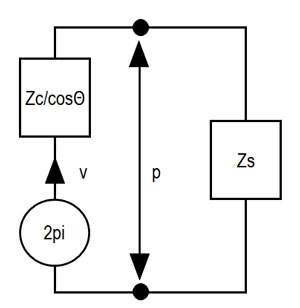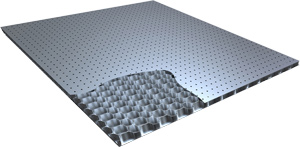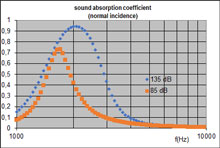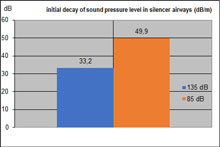Main applications of perforated acoustic panels
It is well known that perforated panels can be used as constituents of products or constructive systems for soundproofing:
- with regard to sound absorption: for controlling the reverberation of premises (e.g. speaking and listening rooms of all kinds [1], catering areas, sports halls, offices - among which: open spaces - and industrial premises), in particular in the form of wall panels or ceiling elements or under-roof constructions (depending on the context: in metal, wood, or plaster-based)
- with regard to sound reduction: for the diminution of sound transmission through walls (e.g. enclosure for machines, soundproof buildings for large installations, screens) in particular in the form of insulation panels allowing the construction of structures (partitions - depending on the case: between floor and ceiling or roof -, roofings, and also: noise barriers), often metallic (steel or aluminum, in the form of sheets)
- with regard to what concerns the insertion loss of silencers (i.e. of devices intended to limit the propagation of noise in aeraulic or pressurized gas networks without opposing the passage of the ducted fluid) in particular under the form of packings called baffles (when the section of the noise limitation device is rectangular or square) or in the form of a peripheral lining, a central element or concentric shells (when it comes to cylindrical silencers), often metallic (in steel, stainless or not) - exceptionally in plastic (e.g. for specific installations for the treatment of acid fumes)
General information on the acoustic behavior of ordinary perforated panels
Very often, the perforated plates (depending on the case: flat or with a curve), within the framework of a soundproofing project, are chosen with a characteristic dimension of their orifices [2] (e.g. circular, square, oblong or slit-shaped [3]) and their spacing [4] (in the first two cases: with orthogonal or hexagonal array i.e. staggered ; in the last two cases: with parallel drilling lines) such as the perforation rate is large enough [5] to induce a neutrality of this layer for what concerns the performance of the considered product or the constructive system ; the justification for the presence of such elements in the multilayer acoustic structures is then the mechanical protection requirements (e.g. against shocks), the supporting of materials [6] (with or without surfacing [7], installed at the rear) - when these are not other considerations relating to visual aspect -.
Some panels for reducing reverberation in public axces buildings premises (PAB e.g. train stations and airport halls, courtrooms) differ from what has been described previously only by a reduced perforation rate [8]; they then participate in the overall performance of the soundproofing product or constructive system in which they are incorporated, according to the principle of the Helmholtz resonator [9].
With regard to all these perforated plates integrated into products implemented in a context of reverberation control of premises or noise reduction (e.g. in buildings, in the environment, in transport equipment and for industrial sites), and for a long time:
- ITS has the know-how to carry out predictive acoustic calculations: both with regard to their intrinsic multi-factorial performance and with regard to their use in concrete cases of construction of equipment or works, namely with software developed internally [10] used in the context of engineering missions or marketed in ASP mode[11] [12]
- ITS sells many components and systems [13]
Particularities of panels with millimeter or sub-millimeter perforations in terms of acoustics
Panels with millimetric or sub-millimetric perforations differ from ordinary panels, in a soundproofing context, in that they contribute more strongly - at least: in a frequency band that can be extended - to the acoustic performance of the multilayer structure in which they are inserted, when they do not dispense with the use of any other porous layer other than air at their back.
Indeed, the combination of a small size for their orifices and a reduced perforation rate gives them - in whole or in part - properties of the same nature as those which generally lead to the use of soundproofing materials (porous) conventional materials [6] and the use of thin plates induces specific phenomena.
The resulting characteristics (in terms of acoustic impedance [14] [15]) for panels with millimetric or sub-millimetric perforations - provided that the right choices are made in terms of acoustic dimensioning to use, in the best possible way, the viscous, thermal and inertial effects linked to the presence of a fluid passing through orifices - are appropriate:
- for sound absorption
- for sound attenuation (e.g. in ducts, and therefore for noise reduction devices that silencers are)
One of the applications of micro-perforated plates in the aeronautics and space sector is the attenuation of noise (e.g. of reactors) by means of thin panels which consist only of a plate with multiple holes, and a cavity (without special filling except air) located at the rear ; to do well, an impervious rigid back and transverse partitions are needed, to what the concept of honeycomb sandwich panel responds quite well (cf. figure 1)
|
Fig. 1 micro-perforated plate constituting the superficial layer of a honeycomb sandwich panel |
Concerning the feasibility of transposing such a concept which has proven itself to other fields: although infrequently implemented at the time of writing this article, other applications - based on the same physical principles and on similar constructions, and that would be innovative solutions if used where they are presently not in use - seem possible to take advantage of a solution less dependent than others on filling materials, generally expensive and subject to various physico-chemical hazards when in contact with fluids (and to the ravages of time), and not always neutral for the environment (e.g. when there are polluting gaseous emissions from some foams, or harmful particulate emissions from some fibrous materials).
As a very significant dissipation of acoustic energy can be obtained with a limited total thickness of the sound-absorbing linings of such a kind, products and construction systems using micro-perforated plates have the advantage of compactness, and thus, in the case of dissipative silencers, they can limit the total pressure loss (by increasing the free section for gas flow - all other things being equal -) of such noise reduction devices whose aerodynamic (aeraulic) performance is often a dimensioning criterion of primary importance.
Aptitude for aerodynamic performance in the case of application for silencers, and - in all cases - high sound dissipation, compactness and quasi-inalterability (when metallic, on the condition of selecting a steel grade or an alloy e.g. based on aluminium, appropriate to the context) are thus characteristics of panels with millimetric or sub-millimetric perforations that it is possible to consider, in many contexts, as majors assets for quality soundproofing constructive systems.
At the time of writing this article, it is premature to answer the question of the exact extent to what such an alternative can, in practice, be a disruptive technology technology for a wide variety of applications, for what the capacity to model in a sufficiently reliable way the phenomena involved is necessary, the possibilities offered in this field by the software SILDIS® founding the present communication.
The future will tell how much this concept of panels with millimetric or sub-millimetric perforations for soundproofing will have found significant outlets in fields such as the reduction of reverberation and noise in public access buildings (PAB) or the industrial acoustical insulation (e.g. sound absorbing linings for test benches, large silencers such as for gas turbine air intakes, cooling tower suction and discharge sections).
Specificities of acoustic sizing calculations of panels with millimetric or sub-millimetric perforations for soundproofing with SILDIS® software
In addition to what has already been communicated on the occasion of a previous article [10], it can be mentioned that modules 1 and 1B of the SILDIS® software [16] take into account - here too: with a pragmatic approach, and with an orientation towards solutions in terms of applied industrial acoustics - a specific phenomenon (often neglected for more ordinary sound absorbing linings): non-linearity for operating conditions involving high noise levels.
The peculiarities of the panels with millimetric or sub-millimetric perforations for soundproofing (as mentioned in the previous paragraph) make it necessary to take into account the fact that, for a given frequency, depend on the characteristics of the sound excitation: the acoustic impedance [14] [15], and (therefore) quantities which are linked to it such as:
- the sound absorption coefficient of an sound absorbing lining
- the transmission loss of a silencer
Depending on the combination of the physical parameters being specific for each context (thermodynamic conditions, geometrical characteristics and properties of the layers of porous media, sound excitation modalities), the variability of these acoustical performances can be more or less important (often: in an extended frequency range) due to the complex mechanisms being involved e.g. in the event of exposure to high noise levels with or without a moving fluid (cf. figure 2 and figure 3).
Some of these parameters are (ordinarily) considered for the simulation of the linear behavior of a sound absorbing linings, others having to be specifically modeled when there is non-linearity.
The calculations carried out with the SILDIS® software in relation to the acoustic impedance [14] of structures (eventually: multilayered) involving micro-perforated panels namely take into account:
- the sound pressure level to which the sound absorbing lining is exposed, with input data being possibly:
- incident level (sound reflections modeling being part of the calculations made by SILDIS® software) [17]
- total level (taking into account the phenomenon of sound reflection) as input data [17][18]
- the frequency distribution of noise:
- sine swept source i.e. an harmonic (sinusoidal) excitation of which frequency is continuously increased [17]
- white noise in a defined frequency range, and with a given frequency increment [17]
- sound pressure spectrum per 1/3 octave band [17][18]
Furthermore, the speed of a grazing gas flow influences not only the modalities of sound propagation in the airways of a silencer and the self noise (i.e. due to the flow) as in the case of other sound-absorbing linings: panels with millimetric or sub-millimetric perforations have, with respect to the physical quantity that the Mach number is, a particular sensitivity whose effect is a modification of the resistance (real part) and of the reactance (imaginary part) of their (complex) acoustic impedance [14] [15] due to their lower porosity.
This modification of the properties of an acoustic structure including plates with microperforations greatly complicates the calculations of prediction of acoustic performance, especially since there is then no explicit formulation for the acoustic impedance [14] [15] whose evaluation must be concomitant with the determination of the particle velocity, a physical quantity which is linked to it.
This is even more true in the case of dissipative silencers: in the direction of the flow, the noise attenuation due to the presence of the sound absorbing lining modifies for each centimeter traveled by the sound waves the local amplitude of the acoustic excitation and therefore, in the case of microperforated panels submitted to high sound intensity, the properties of the sound-absorbing lining themselves are gradually changed (while they are constant over the entire length of the silencer in the case of linear regime) ; the sound pressure level decay in the airways is then not uniform over the entire length [19] ; the list of the input data useful for the (multidisciplinary) design of a silencer for a linear regime must be extended to the additional consideration of the frequential distribution of sound pressure level at silencing device inlet in case of non-linear regime [20].
This is an invariant of the software SILDIS®: the calculations (even when involving hyperbolic trigonometry functions or Bessel functions - all: with complex argument -) and requiring iterations for the resolution of transcendental equations - involving sophisticated multifrequential algorithms - are carried out with Excel, which allows a great facility for the realization of simulations by the user of SILDIS®.
This is therefore also the case for taking into account the non-linearity of the acoustic behavior of micro-perforated plates, making loop calculations necessary for the determination of quantities which are not independent of each other in the presence of high noise levels.
This is also the case for the other calculations that can be performed with modules 1 and 1B of the SILDIS® software (for which connected information can be found elsewhere on this blog [21] [22] in this blog [23]) : the modeling of panels with millimetric or sub-millimetric perforations for soundproofing is fully configurable, and can be performed without known limitations of input data, which opens up the field of possibilities in terms of applications.
As for the calculations relating to other sound absorbing linings, the acoustic performance simulations involving microperforated plates with the SILDIS® software can relate to multilayer acoustic structures combining porous media, surfacings and perforated plates (with thickness, size of the perforations and perforation rates variable on demand) for multi-factorial parametric studies [24] .
The results of simulations, with SILDIS® software, of the acoustic performance of micro-perforated panels compare favorably with measurements, including those reported - at the time of writing this article - in the most recent scientific publications (e.g. in the context of engineering studies, research and development works in the field of aeronautics and space).
What can be expected from calculations for the acoustic dimensioning of panels with millimetric or sub-millimetric perforations for soundproofing with the SILDIS® software is thus a detailed and exhaustive consideration of the parameters influencing the acoustic performance of constructions in which they can be integrated for sound-absorbing linings as for silencers, also with the consideration (for circular drillings) of a grazing flow or of high sound levels [25]:
- for what concerns sound absorption (cf. figure 2) , the results of the calculations are comparable to the standard measurement: cf. NF EN ISO 354 Acoustics - Measurement of sound absorption in a reverberation room and also standard ISO 10534-1 Acoustics - Determination of the sound absorption coefficient and impedance in impedance tubes - Part 1: Method using standing wave ratio
- for what concerns silencers (cf. figure 3), such air networks components can be of rectangular, square or circular cross section ; the results of the calculations are comparable with the standardized measurement: see NF EN ISO 7235 Acoustics - Laboratory measurement procedures for silencers in ducts and terminal units - Insertion loss, flow noise and total pressure loss
|
Fig. 2 illustration of non-linearity of the response of a micro-perforated plate to sound excitation: acoustic absorption coefficient under normal incidence (with a ratio circular perforations diameter to thickness being 1, a porosity being 2 %, a cavity depth 0.01 m, a scanning sinusoidal source with a level of 85 dB or 135 dB (accoutning reflections on the sound absorbing lining) |
|
Fig. 3 illustration of the non-linearity of the response of a micro-perforated plate to sound excitation: initial decay of sound pressure level (dB/m) for a dissipative silencer made up of 0.1 m airways and micro-perforated plates described in figure 2, with the service conditions of figure 2 (propagation loss per unit length valid at the silencer inlet) ; the resonnance frequency of the sound absorbing liner (in the 1/1 octave band 2kHz) is considered |
The acoustical sizing calculations of panels with millimetric or sub-millimetric perforations for soundproofing with the SILDIS® software can be carried out either by the human resources of ITS (which has developed and which markets this simulation tool: software publishing is an ITS activity assessed to meet the requirements of standard ISO 9001), or by self-service (with subscription) in ASP mode [26] (for the dedicated sub-module: with a special rate and after specific training for picking up a software tool with functionalities being out of the ordinary).
[1] e.g. classrooms and training rooms, meeting rooms, lecture halls, musical venues (for shows and for rehearsals)
[2] several millimeters
[3] below (from left to right): illustrations of circular perforations (orthogonal or hexagonal arrangement), square or slotted
[4] several millimeters or even centimeters
[5] several tens of percent (quasi-neutrality is generally agreed for a value of the order of 30%)
[6] in particular mineral fibers (rock-based e.g. basalt), ceramic fibers, fiberglass, polyester-based, foams
[7] including glass cloth, fabric, knit
[8] 10% (in terms of order of magnitude)
[9] each orifice of the perforated plates constitutes a neck which, connected to a volume (the layer of porous material located at the back - of variable properties -) has an acoustic behavior very dependent on the frequency
   
geometry of plates with (in display order) circular (orthogonal or hexagonal arrangement), square or slotted perforations taken into account with the software SILDIS® |
[10] Acoustics – Design and sizing of plate resonators with circular, square or slotted perforations (for silencers and absorbing linings) with software SILDIS®
[11] ASP = Application Service Provider
[12] Computer Aided Design (CAD): SILDIS® calculation software for acoustics and aeraulics in the construction sector (in Excel format)
[13] Products & solutions
[14] ratio of the acoustic pressure (to which a voltage corresponds when an electrical analogy is made) to the particle velocity of sound waves (to which the intensity of a current corresponds when an electrical analogy is made)
[15] simplified electro-acoustic analogy in case of an acoustic structure of small thickness (pi=incident sound pressure in Pa, p=sound pressure accounting reflections in Pa, v=particle velocity in ms-1, Zc=impedance of the acoustic structure including the rear layer (impervious rigid back or atmosphere) in Nsm-3, Zc=characteristic impedance of the fluid in Nsm- 3, Θ=angle of incidence of the sound waves with respect to the normal to acoustic structure surface plane in degrees)
 |
[16] Prediction of acoustic and aerodynamic performance of silencers - software SILDIS® Module 1
[17] e.g for comparisons with laboratory measurements results
[18] e.g. for sound sources encountered in practice
[19] cascading uses of the SILDIS® software, for discretization of the properties of the sound absorbing lining (considered as locally reacting for the determination of propagation loss) depending on (segmented) length, allow the evaluation of the acoustic performance sought for the full length of the silencer ; even more than in the case of an ordinary dissipative liner, the development of a silencer allowing the attenuation of noise in a - more or less wide - frequency range of interest must, in the event of recourse to panels with millimetric or sub-millimetric perforations, be subject to trial and error process (for what the experience acquired through repeated practice of such computations will count ?) due to antagonisms relating to the various phenomena involved
[20] cf. other post in this website: What are the input data useful for the design of a silencer?
[21] cf. other post in this website: Modeling of dissipative silencers - refinement of the calculation of acoustic performance
[22] cf. other post in this website: Acoustics and aeraulics - 9 minutes are enough for the complete calculation of a silencer
[23] cf. ITS R&D blog
[24] possibilities for the simulation of multilayer structures with SILDIS®

Illustration of layer combinations possible with the software SILDIS® for calculations in relation to silencers and absorbing linings (some layers, with the exception of the « rear » layer, can - where required : easily - be ignored, depending on the acoustic structure to be simulated). « rear » : symetry plane / impervious rigid back or atmosphere (2 possibilities) - C, G, K, O : porous medium - D, H, L, P : cloth - E, I, M, Q : perforated protection |
[25] at the time of writing this article, the simultaneous consideration of a grazing flow and of high sound levels is subject to in-house development efforts
[26] ASP = Application Service Provider from 250 €/month i.e. 277.50 US $/month ; the fixed price is that indicated in € (the price expressed in US $ is valid, as on December 5, 2019, when 1 € = 1.11 US $) ; VAT with a rate of 20% extra (if applicable, i.e. only for customers established in France) ; commissioning extra


